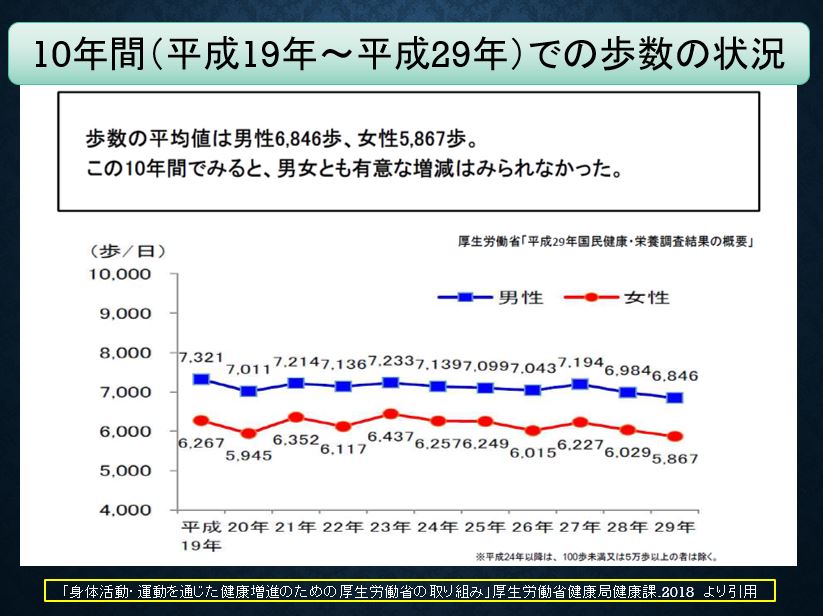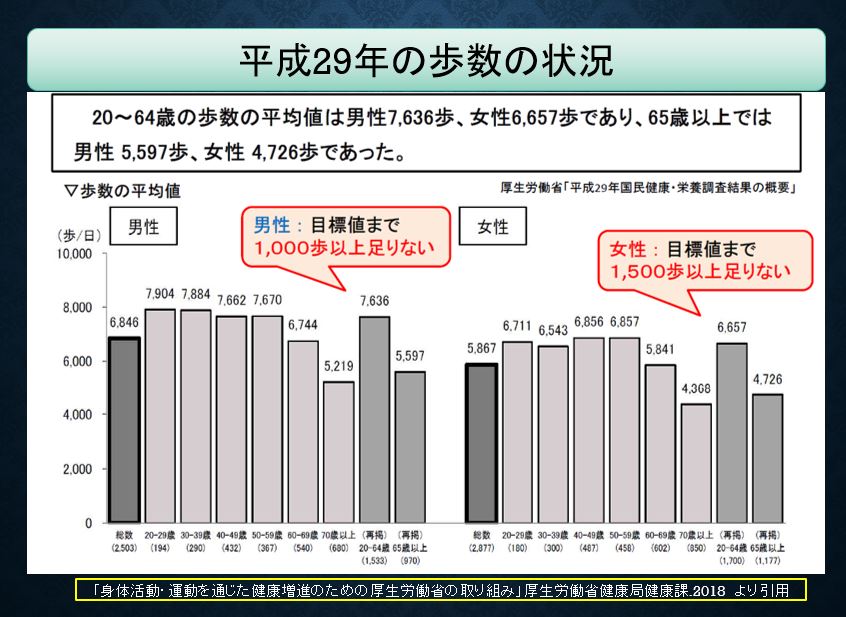こんにちは!!
運動器専門のリハビリスタッフです!!
いつもお世話になります。
今回は『1日10,000歩、歩きなさいは間違い?その理由と根拠は・・・』について解説していきたいと思います。
◆1日10,000歩伝説
世間では1日10,000歩を歩くことで健康になることが信じられており、
医師やトレーナー、リハビリの先生から「1日10,000歩、歩きましょう」と言われることがあると思います。
1日10,000歩というのはピンとこないかもしれませんが、30代男性でリハビリ職である私は毎日、通勤で(2500歩×往復)+7000歩(病院勤務中)=12,000歩程度です。
高齢者や事務職など運動量が少ないような方では1日10,000歩は過酷なのかもしれません。
そもそもこの1日10,000歩とは根拠のある数字なのかも怪しいところです。
◆健康日本21での歩数の目標
健康日本21とは厚生労働省によって国民の健康を増進するため平成15年に策定された指針です。
平成24年の健康日本21(第二次)では、【日常生活における歩数の増加】という項目で、2022年の歩数の目標が掲載されています。
20歳~64歳:男性9,000歩、女性8,500歩
65歳以上:男性7,000歩、女性6,000歩
H22年時点では
20歳~64歳:男性7,841歩、女性6,883歩
65歳以上:男性5,628歩、女性4,584歩
でしたので約10年で、1日1,500歩増加させることを目標としているようです。
・目標の根拠
1日1,500歩の増加はNCD(非感性性疾患)発症及び死亡リスクの約2%減少に相当し、血圧が1.5mmHg減少につながる
◆ここ10年間の歩数の推移
・10年間の(H19年~H29年)での歩数の状況

| H19年 | H20年 | H21年 | H22年 | H23年 | H24年 | H25年 | H26年 | H27年 | H28年 | H29年 | |
| 男性 | 7,321歩 | 7,011歩 | 7,214歩 | 7,136歩 | 7,223歩 | 7,139歩 | 7,099歩 | 7,034歩 | 7,194歩 | 6,984歩 | 6,846歩 |
| 女性 | 6,267歩 | 5,945歩 | 6,352歩 | 6,117歩 | 6,437歩 | 6,257歩 | 6,249歩 | 6,015歩 | 6,227歩 | 6,029歩 | 5,867歩 |
ここ10年間の歩数の平均値は男性7,109歩、女性6,160歩です
この10年間では歩数は大きく変化していないようです。
・平成29年の歩数の状況

| 総数 | 20~29歳 | 30~39歳 | 40~49歳 | 50~59歳 | 60~69歳 | 70歳以上 | 20~64歳 | 65歳以上 | |
| 男性 | 6,846歩 | 7,904歩 | 7,884歩 | 7,662歩 | 7,670歩 | 6,744歩 | 5,219歩 | 7,636歩 | 5,597歩 |
| 女性 | 5,867歩 | 6,711歩 | 6,543歩 | 6,856歩 | 6,857歩 | 5,841歩 | 4,308歩 | 6,657歩 | 4,762歩 |
年代別で見てみると、やはり男性も女性も60歳を超えると歩数が低下しています。
◆1日10,000歩は根拠がない?
ここ10年間の歩数の平均値は男性7,109歩、女性6,160歩です
H29年の歩数では、平均値は男性6,846歩、女性5,867歩です
このあたりの歩数の数値では1日10,000歩に3,000~4,000歩足りていませんが、健康的に問題が生じやすいのか、研究や科学的データを基に調べてみたいと思います。
・論文紹介
下記の論文は2019年に報告されたもので、1日10,000歩も歩かなくても健康は維持されることを証明しています。
Association of Step Volume and Intensity With All-Cause Mortality in Older Women
高齢女性における歩数および強度と全死亡率との関係
JAMA Intern Med . 2019 Aug 1;179(8):1105-1112.
I-Min Lee 、Eric J Shiroma 、Masamitsu Kamada 、David R Bassett 、Charles E Matthews 、Julie E Buring
Abstract概要
Importance: A goal of 10 000 steps/d is commonly believed by the public to be necessary for health, but this number has limited scientific basis. Additionally, it is unknown whether greater stepping intensity is associated with health benefits, independent of steps taken per day.
【重要性】
健康のためには10,000歩/日の歩数が必要であると一般に信じられているが、この歩数には科学的根拠が乏しい。さらに、1日あたりの歩数とは別に、歩数の強度が高いほど健康上のメリットがあるかどうかは不明である。
Objective: To examine associations of number of steps per day and stepping intensity with all-cause mortality.
【目的】
1日の歩数および歩幅の強度と全死亡率との関連を検討する。
Design, setting, and participants: This prospective cohort study included 18 289 US women from the Women’s Health Study who agreed to participate by wearing an accelerometer during waking hours for 7 days between 2011 and 2015. A total of 17 708 women wore and returned their devices; data were downloaded successfully from 17 466 devices. Of these women, 16 741 were compliant wearers (≥10 h/d of wear on ≥4 days) and included in the analyses, which took place between 2018 and 2019.
【デザイン,設定,および参加者】
この前向きコホート研究では、2011年から2015年の間に7日間、起床時に加速度計を装着して参加することに同意したWomen’s Health Studyの米国女性18 289名を対象とした。計17,708人の女性が装着して機器を返却し、17,466台の機器からデータが正常にダウンロードされました。これらの女性のうち、16,741人がコンプライアンスのある装着者(4日以上で10時間/日以上の装着)であり、2018年から2019年にかけて実施された分析に含まれた。
Exposures: Steps per day and several measures of stepping intensity (ie, peak 1-minute cadence; peak 30-minute cadence; maximum 5-minute cadence; time spent at a stepping rate of ≥40 steps/min, reflecting purposeful steps).
【評価】
1日あたりの歩数と、ステップ強度のいくつかの測定値(すなわち、ピーク1分ケイデンス、ピーク30分ケイデンス、最大5分ケイデンス、目的のあるステップを反映した40ステップ/分以上のステップ速度で過ごした時間)。
Main outcomes and measures: All-cause mortality.
【主な結果と評価】
全死亡率。
Results: Of the 16 741 women who met inclusion criteria, the mean (SD) age was 72.0 (5.7) years. Mean step count was 5499 per day, with 51.4%, 45.5%, and 3.1% of time spent at 0, 1 to 39 (incidental steps), and 40 steps/min or greater (purposeful steps), respectively. During a mean follow-up of 4.3 years, 504 women died. Median steps per day across low-to-high quartiles of distribution were 2718, 4363, 5905, and 8442, respectively. The corresponding quartile hazard ratios (HRs) associated with mortality and adjusted for potential confounders were 1.00 (reference), 0.59 (95% CI, 0.47-0.75), 0.54 (95% CI, 0.41-0.72), and 0.42 (95% CI, 0.30-0.60), respectively (P < .01). In spline analysis, HRs were observed to decline progressively with higher mean steps per day until approximately 7500 steps/d, after which they leveled. For measures of stepping intensity, higher intensities were associated with significantly lower mortality rates; however, after adjusting for steps per day, all associations were attenuated, and most were no longer significant (highest vs lowest quartile for peak 1-minute cadence, HR = 0.87 [95% CI, 0.68-1.11]; peak 30-minute cadence, HR = 0.86 [95% CI, 0.65-1.13]; maximum 5-minute cadence, HR = 0.80 [95% CI, 0.62-1.05]; and time spent at a stepping rate of ≥40 steps/min, HR = 1.27 [95% CI, 0.96-1.68]; P > .05).
【結果】
取り込み基準を満たした16 741人の女性のうち、平均年齢は72.0±5.7歳であった。平均歩数は1日あたり5499歩で、そのうち0歩が51.4%、1~39歩(偶発的な歩数)が45.5%、40歩/分以上(目的を持った歩数)で過ごした時間は3.1%であった。平均4.3年の追跡期間中に504人の女性が死亡した。分布の低い方から高い方までの1日あたりの歩数の中央値は、それぞれ2718、4363、5905、8442だった。死亡率に関連し、潜在的交絡因子を調整した四分位のハザード比(HR)は、それぞれ1.00(参考値)、0.59(95%CI、0.47-0.75)、0.54(95%CI、0.41-0.72)、0.42(95%CI、0.30-0.60)であった(P < 0.01)。スプライン解析では、HRは1日の平均歩数が多いほど徐々に減少し、約7500歩/日までは横ばいであった。歩数の強度については、強度が高いほど死亡率が有意に低かったが、1日当たりの歩数で調整すると、すべての関連性が弱まり、ほとんどの関連性はもはや有意ではなかった(1分間のピークケイデンスの最高四分位と最低四分位、HR = 0. 87 [95% CI, 0.68-1.11]; ピーク30分ケイデンス, HR = 0.86 [95% CI, 0.65-1.13]; 最大5分ケイデンス, HR = 0.80 [95% CI, 0.62-1.05]; 40歩/分以上の歩数で過ごした時間, HR = 1.27 [95% CI, 0.96-1.68]; P > 0.05)。)
Conclusions and relevance: Among older women, as few as approximately 4400 steps/d was significantly related to lower mortality rates compared with approximately 2700 steps/d. With more steps per day, mortality rates progressively decreased before leveling at approximately 7500 steps/d. Stepping intensity was not clearly related to lower mortality rates after accounting for total steps per day.
【結論と関連性】
高齢女性において、約4400歩/日の少ない歩数は、約2700歩/日と比較して、死亡率の低下に有意に関連していた。1日の歩数が増えるにつれて、死亡率は徐々に低下し、約7500歩/日で横ばいとなった。1日の総歩数を考慮しても、歩数の多さと死亡率の低下には明確な関係はなかった。
まとめ
以上のことから、1日4,400歩以上歩けば死亡率は低くなり、平均歩数の増加とともに死亡率は低下するそうです。
しかし、7,500歩以上になると、それ以上死亡率は低下しないとされており、1日10,000歩の根拠は示されていません。
もちろん10,000歩を歩くことが悪影響とはならないと思われますが、そこまで歩かなくても健康は維持されるようです。
平成24年の健康日本21(第二次)では、2022年の歩数の目標を
20歳~64歳:男性9,000歩、女性8,500歩
65歳以上:男性7,000歩、女性6,000歩
としていますが、上記論文の7,500歩というところと照らしても妥当性はあるように思います。
まずは1日7,500歩を目指すということで良いのかもしれませんね。
今回は『1日10,000歩、歩きなさいは間違い?その理由と根拠は・・・』を解説させていただきました。



